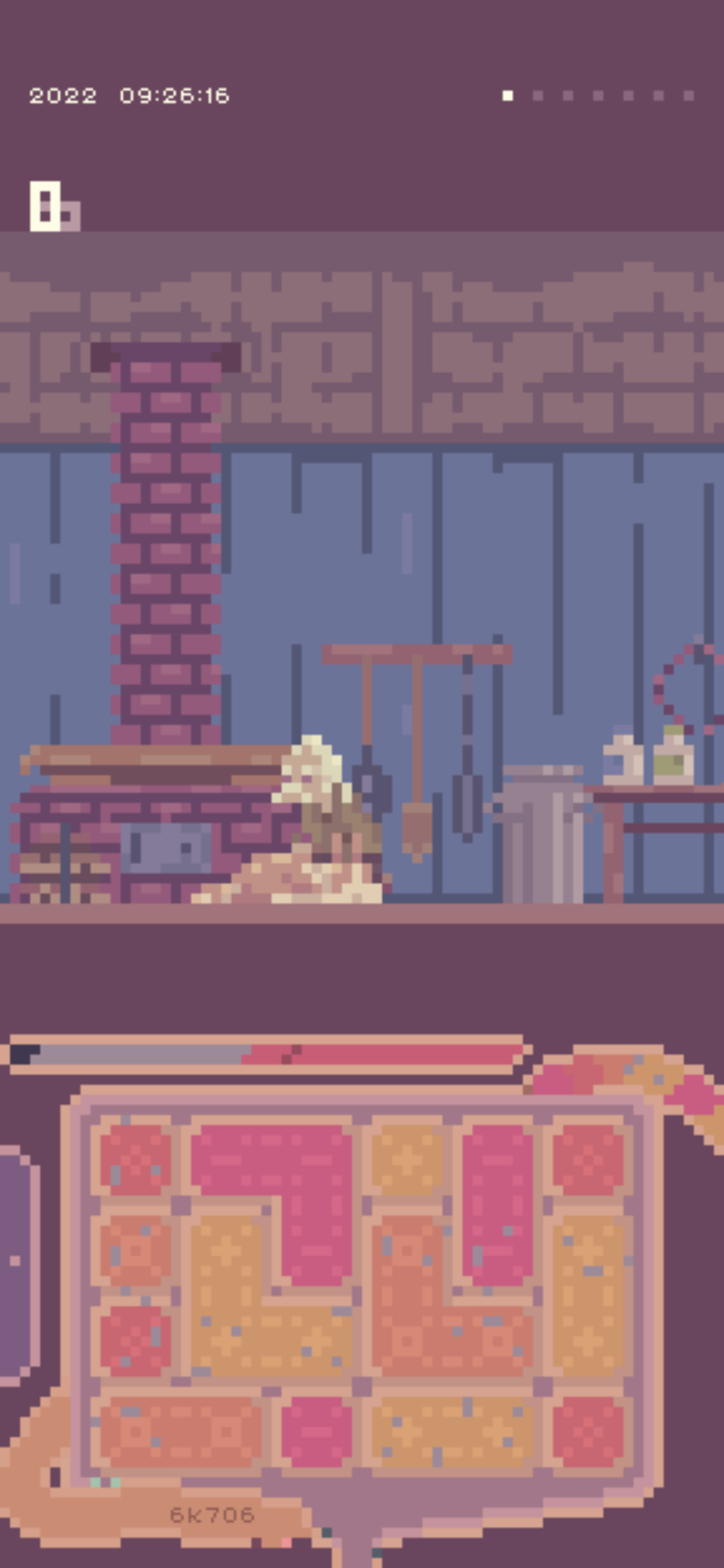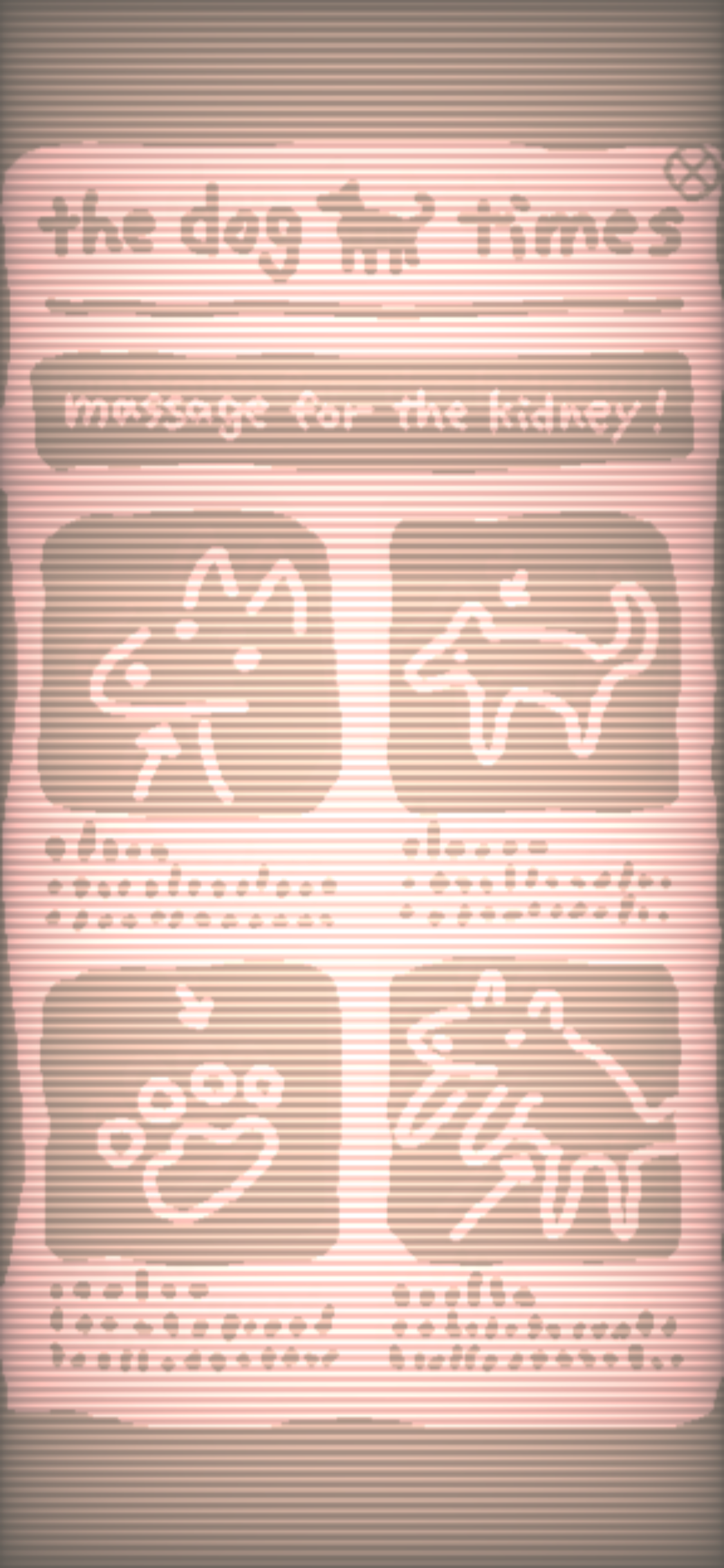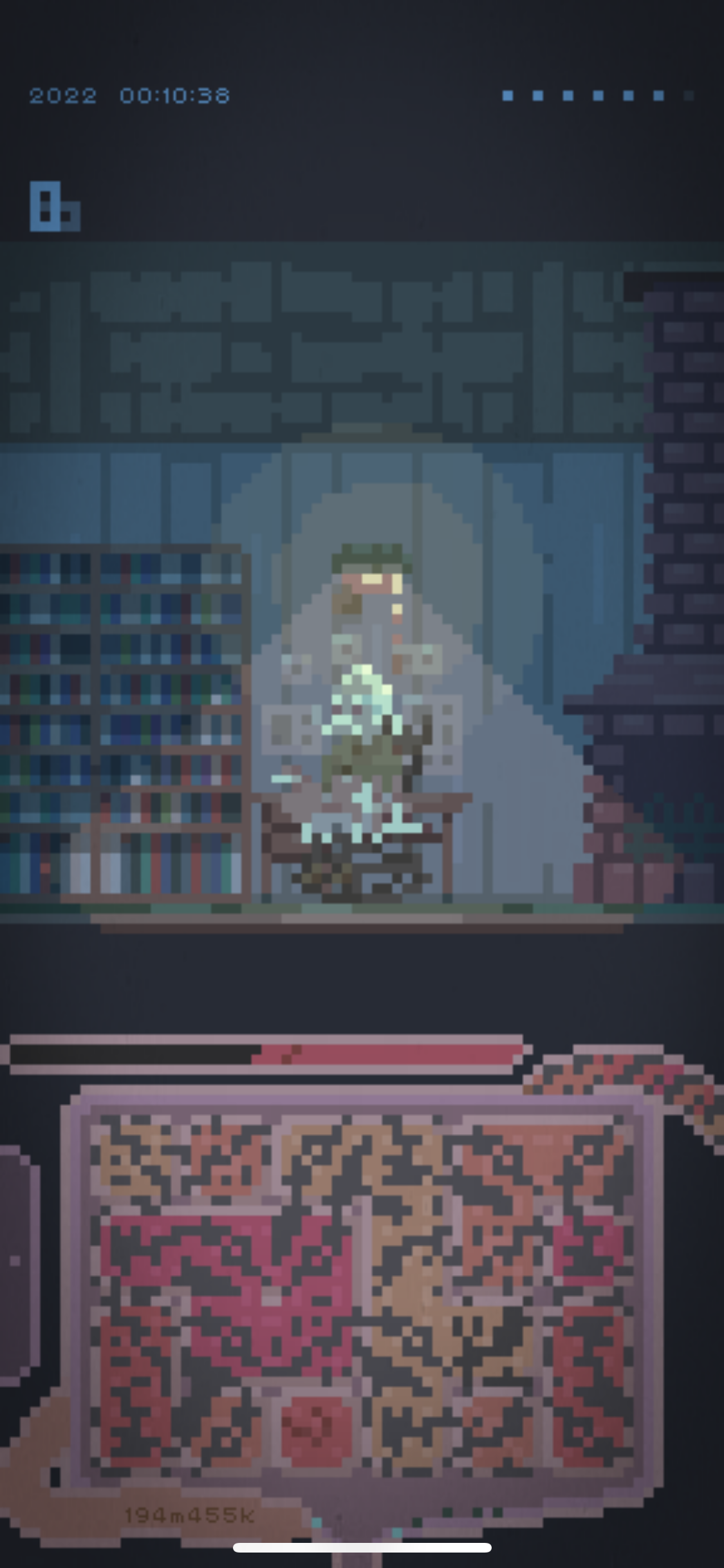renal summer
If you knew you had exactly seven days to live, how would you spend your time? And if you knew someone you cared for had seven days to live, how would you make their final moments easier?

renal summer is a time-based simulation game in which players take on the role of the kidney of a dog who is slowly dying of kidney failure. The dog's death is a foregone conclusion, but by clearing impurities from their bloodstream, the player can ease their suffering and help them live a more normal life in their remaining time.
renal summer is by Japanese solo game developer tokoronyori[1], known for his stark visual style and dark themes. Although he's been publishing games for mobile devices under this name since 2016, western players are probably most familiar with farewell planet (Mac/Windows/mobile, 2019), his first game to be localized. His games tend to focus on themes of loss and acceptance, with an understated wry sense of humour and an incorporation of stereotypical "gamish" elements into their core structure. farewell planet, for example, hangs its story on the simple structure of a fetch quest adventure game, while hitohoroboshi (2016) builds on simple physics-based action games and the universal player score of Keita Takahashi's Noby Noby Boy (2009). He consistently explores the ways in which these simple mechanics affect the player's conception of the stories they're attached with, and the ways in which even simple game mechanics evoke feelings in the player.
Players start renal summer purely as an observer. As its lovely opening song plays, the player slowly follows the two main characters through their daily routine. The dog and the old man live on a remote farm, far away from anyone else; they follow a routine of working the farm equipment, puttering around home, having meals together. This routine follows the actual clock; they sleep at night, wake in the morning, work when the sun isn't yet too hot. As time passes in real life, it passes in the game, so as the player picks up their phone, they'll find the two of them living their life in different ways.

The second half of the game is introduced after a few minutes of watching their routine for the first time. On the bottom half of the screen, the player sees a representation of the dog's blood—and here, unlike the other screen, the player can interact. This intro serves as a reminder to the player: you're not the dog, and you're not the old man. You're simply a liver; you can't speak, you can't act or direct anyone. All you can do is purify blood.
The player clears impurities from the dog's bloodstream via a simple match-based puzzle game. The game field is filled with coloured squares, and players must tap them repeatedly to destroy them. The larger a collection of coloured squares the player is able to group together, the fewer taps it takes to clear that group. By being strategic, the player is able to minimize the amount of effort it takes to keep working. Above the playfield is a small "blood bar" meter showing the current level of impurities in the blood; the more blocks the player clears, the healthier the dog is able to stay. Periodically, the player is granted a powerup which allows them to effortlessly clear blocks with a single tap; these also grant the player the chance to read an issue of the "Dog Times" in-game newspaper, which is the only place any element of the game's story is explicitly explained.

This gameplay cycle takes place over seven real-time days. The core gameplay loop is intentionally simplistic, and while on its own wouldn't sustain the player's attention for so long, it lives in symbiosis with the other half of the game. They're just a liver, not a person, but they're not a liver in a vaccum; it's the careful balance of gameplay and observation that drives the player's engagement. The dog and the old man live out their lives without the player's input, but observation itself, absent a direct method of interaction, is still a core game mechanic. Their schedule carries on whether the player is watching or not, and when the player is watching they have no influence whatsoever on what they're doing. No influence, that is, except for one major exception: whether the dog is well enough to live their normal life. The small bar above the player's puzzle field has a small mark in the centre. Once the current position of blood impurities passes it, the dog starts to weaken and they will lose their ability to take part in their normal routine.
The old man and the dog's lives are depicted using a fluid animation technique reminiscent of Capcom's Ghost Trick (2010)—also a game that actively denies the player input and control over events. It applies the broad techniques of pixel animation to something that moves more akin to non-game animation. Game animation is usually marked by affordances designed around the need of interaction. Individual animations need start/stop times that must take into account player input in order to feel responsive; animations frequently include rough "snaps" or awkward tweens when transitioning between arbitrary animations; and so forth. Game animation is a collaboration between animator and player—often a one-sided one, where the animator hopes to erase the other side's awareness of that collaboration. Here, though, players have been forcibly cut out, and the animation is a visible and tangible reminder of that. This is animation with no room for the player's input. It's a kind of beauty that keeps the player carefully shut out, despite the surface-level pixel aesthetic that implies the player's active input.
The player is never explicitly taught most of the game mechanics; they're left to intuit what's happening from observation. Most players are familiar with health bars, so the blood bar above the playfield is pretty obvious players even if it seems to fill in reverse from the normal order. Less obvious is that its size shrinks over time; while the total width is always the same, a dead zone on the left side slowly grows as the hours and days pass. Because the mark in the centre never moves, the amount of healthy blood reduces steadily with time. Players may well fail to notice for the first few days, but eventually it becomes clear: the dog doesn't have much time, and working to keep them healthy will become harder and harder.

renal summer doesn't just adopt its primary mechanics from mobile games; it also coopts the push notification model of free-to-play games. Many mobile games are designed to be played compulsively many times a day, in intense bursts instead of in single hours-long sessions. On top of mechanics designed to require players to space out their play in a way that reinforces engagement (and addiction), many games incorporate notification-based nags to actively remind players to open the app. These often include notifications for timed gameplay mechanics such as refilling stamina, the completion of hours-long tasks while the app was closed, and so on. They also frequently include simple nags to bring the player back, anything from sale announcements to basic reminders to emotionally manipulative comments such as "I'm lonely!" and "I miss you!" presented as coming from game characters. While the format changes, the intent is always the same: get the player returning many times a day to build their engagement with and addiction to the game and, by doing so, increase the chance they'll spend money.
That renal summer engages with these mechanics doesn't mean it has the same goals. There's many things that differentiate it: a session rarely lasts more than a few minutes at a time; there's only one thing the player can spend money on, the ability to remove ads, which doesn't provide the player with any in-game advantages at all; and the game only lasts for a maximum of seven real-time days. There's no room for players to form this kind of relationship, leaving a space for these mechanics to have a very different emotional effect.
renal summer's push notifications also encourage the player to check in, but not to spend money. As the dog's health declines in realtime, notifications provide the player with warnings as the dog's health worsens. The goal here isn't just to bring the player into the game, but provide a sort of metatextual feedback on the dog's health. By receiving notifications outside the game, the player's daily life starts to incorporate a sense of the dog's condition and a feeling for how long they stay healthy. As the days go by, and their condition worsens, it takes less and less time for the dog to lose their energy for daily life. The player notices this not just via playing the game but by how the notifications seem to speed up, getting urgent not via content but just via their frequency.

This sense of urgency, and this slowly growing sense of grief and acceptance, is something that slowly dawns on the player over time. Even as the player becomes aware that the dog's condition is declining, despite their best efforts, a devoted player can ensure that the dog feels well enough to live a normal life with only a few spells of weakness. Perhaps the dog will feel rough after the player wakes up in the morning, not having had time to tend to them in their sleep, but they can easily enough make that up without needing to worry about spending too much time. Seven days is just gradual enough that players may not be fully conscious of the difficulty ramping up until it's already happened. By the final day, when the player has finally accepted the near-impossibility of keeping the dog pain-free, it becomes impossible altogether: the maximum level of the blood bar slips below the "comfort" level, and no matter how hard the player works, they must accept that the dog may never again be well enough to return to their daily routine.
As this routine slowly ramps up, one other change happens for the player: very likely, they spend less time watching and more time managing the dog's health. Early in the game, it takes so little work to help out the dog that players will spend most of their short game sessions watching the old man and the dog live out their lives. Playing the game takes little concentration and little time, so players have no problem spending more time becoming immersed. The concentration and the time it takes to help out the dog grow over time as their condition worsens. Players who don't play the game obsessively will find themselves, without intending to, paying less attention to what the dog and the old man are doing and more to managing the dog's health. Should the player think about it, they'd be struck by the dilemma: should they pay less attention to spending the limited time they have left with the dog in order to prolong their life?
In this way it echoes Félix González-Torres's "Untitled" (Portrait of Ross in L.A.)[2], a 1991 interactive sculpture created the year of his partner Ross's death from AIDS. The sculpture comprises a pile of brightly coloured candies which, at the start of the exhibition, represents Ross's ideal pre-AIDS body weight. As gallery visitors take candies, and the gallery itself replenishes them at its discretion, the work remains hung in the moment of life and death. Even a visitor who refuses to take part in depleting the work finds themselves gawking at the metaphorical Ross fading away. While Portrait of Ross is outwardly critical of its audience—whose small actions contribute to the loss of Ross in much the same way society as a whole failed those with AIDS—the two works force the audience to confront the slowness of decline, the gradualness with which life disappears. The player of renal summer may even find themselves identifying with the gallery workers who periodically replenish the work as it fades away, knowing that its decline will continue nonetheless.
These are the little, everyday contradictions of sorrow and impending loss. Becoming numb to loss before it even happens; struggling to treasure the time you have; sudden pangs of emotional agony at strange times. This, too, is part of why the game sends messages to remind you about the dog: these little nudges intrude into the player's life, reminding them less of the game's mechanics than of the events that are happening, the seemingly random pangs of grief and anticipation and anxiety that strike in the midst of daily tragedy.

It's only just as the player has the chance to start accepting this impending loss that they realize something is changing. In the seventh day, the old man suddenly abandons his routines for the first time; he stops tilling the fields, stops tending to the crops, stops taking care of the farm at all. Instead, he begins opening the packages he's been receiving over the course of the game and assembling a machine the player may recognize from issues of the Dog Times—a hibernation device. Once complete, the old man places the dog inside where they can remain until nanomachine dialysis becomes a reality. The dog's death, which the player has only just steeled themselves for, is no longer a certainty. There really is hope. Following a brief epilogue, the game awakens some years in the future, where the slightly older man and his dog are reunited.
In many games, this twist happy ending would cheapen the rest of the game, but the biggest surprise is that it works. The player has become so immersed in their personal despair that they have, perhaps, forgotten about the old man's feelings, but this ending is borne from his personal love rather than the player's. Rather than an unwillingness to accept endings, it manages to feel like an expression of love for a beloved family member, a willingness to do what it takes to help someone in need. Reflecting on it in 2021, tokoronyori expressed the hope that it could be seen not as escapism, but as an expression of love.[3]
It's that sense of love, not loss, that the game leaves the player with. Love alone can't solve every problem, but the pain of loss dulls with time, and love survives.
1. tokoronyori prefers to spell his name in lowercase. ↩
2. “Untitled” (Portrait of Ross in L.A.). Art Institute of Chicago. Retrieved from https://www.artic.edu/artworks/152961/untitled-portrait-of-ross-in-l-a. ↩
3. tokoronyori. [@tokoronyori]. (2021, August 15). renal summerについて、あの7日間は老人が犬の死を受け入れるための7日間であるべきであって、老人の選択は逃避でしかない。故にクソゲー。という意見をよく貰うんですが、あなたはその強くて美しい心のまま、これからも強く美しく生きてくださいとしか言えない。正論すぎて本当にぐうの音も出ない。 [Tweet]. Twitter. https://twitter.com/tokoronyori/status/1426957468509216768 ↩